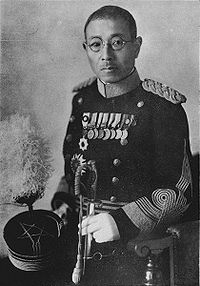- Tetsuzan Nagata
-
Tetsuzan Nagata 
Lieutenant General Nagata TetsuzanBorn January 14, 1884
Suwa, Nagano, JapanDied August 12, 1935 (aged 51)
Tokyo, JapanAllegiance Empire of Japan Service/branch  Imperial Japanese Army
Imperial Japanese ArmyRank lieutenant general In this Japanese name, the family name is "Nagata".Tetsuzan Nagata (永田 鉄山 Nagata Tetsuzan, 14 January 1884 – 12 August 1935) was a general in the Imperial Japanese Army, famous as the victim of the Aizawa Incident of 1935.
Contents
Biography
Nagata was born in Suwa city in Nagano Prefecture. He graduated from the Imperial Japanese Army Academy in October 1904, and from the Army Staff College in November 1911. He served as military attaché to several Japanese embassies in Europe, including Denmark, Sweden, Switzerland, and Germany both before and during World War I.
On Nagata's return to Japan in February 1923, he was assigned to the Imperial Japanese Army General Staff, where he served as administrator of various departments. Promoted to colonel in March 1927, he received command of the IJA 3rd Infantry Regiment, and was promoted to major general, and commander of the IJA 1st Division in 1932.[1]
Nagata was considered a leading member of the moderate Toseiha political faction within the military, led by Kazushige Ugaki, and was also regarded as an expert on Germany.
Nagata was responsible for planning Japan's national mobilization strategy as Chief of Mobilization Section, Economic Mobilization Bureau, Ministry of War, to put both the military and the civilian economy on a total war footing in times of national emergency. His ideas earned him the violent animosity of the radical Kodoha faction within the army who charged him with collusion with the zaibatsu.[2]
Nagata was murdered in August 1935 (the Aizawa Incident), by Lieutenant Colonel Saburo Aizawa with a sword, for supposedly putting the Army "in the paws of high finance". Nagata was posthumously promoted to lieutenant general, and his assassin was shot by firing squad.
Notes
References
Books
- Bix, Herbert B (2001). Hirohito and the Making of Modern Japan. Harper Perennial. ISBN 0-06-093130-2.
- Sims, Richard (2001). Japanese Political History Since the Meiji Renovation 1868–2000. Palgrave Macmillan. ISBN 0312239157.
- Spector, Ronald (1985). Eagle Against the Sun: The American War With Japan. Vintage. ISBN 0-394-74101-3.
External links
- Ammenthorp, Steen. "Nagata, Tetsuzan". The Generals of World War II. http://www.generals.dk/general/Nagata/Tetsuzan/Japan.html.
Categories:- 1884 births
- 1935 deaths
- 1935 crimes
- Japanese generals
- People from Nagano Prefecture
- Murdered military personnel
- Assassinated Japanese people
- People murdered in Japan
Wikimedia Foundation. 2010.
